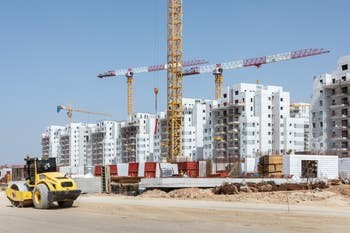The Marker, Gili Melnitsky, 14.10.2020
Ongoing government paralysis, along with a health and economic crisis, are clouding the housing market. "Catastrophe" - is the word that is repeated in conversations we had with senior housing officials.
- UBS: Apartment prices in Tel Aviv are still inflated
- "I'm afraid of the innocence of apartment buyers; I saw a lot, but like in Corona it was not"
- "The drama this time is completely different": Where will the real estate market go the day after the Corona
These general assessments joins an internal report Builders Association Builders of the country, revealing data that should worry the public . Downturn and reforms in marketing land dries on the shelf, will be felt for my wallet homebuyers in the coming years.
1. No land marketing
According to the Contractors Association, the first half of 2020 closed with a 50% drop in the marketing of residential land by the state. In this half, land was marketed for only about 7,000 apartments, compared with 14,000 in the corresponding period in 2019 and about 19.5 thousand that the state marketed in this period in 2018. This means that residential construction reserves will not be filled in the future. In view of the crisis and economic instability , the association estimates that in the coming years a drop in construction starts is expected.
According to the association's estimates, in 2020 a maximum of 15,000 new apartments will be closed (a figure that reflects the number of tenders that were successfully closed and actually purchased by the construction companies). This amount of transactions is very poor compared to the data of recent years, in which 30-40 thousand transactions were successfully closed.
"The apartment buyers should be concerned - the contractors are less," says Shauli Lotan, CEO of the Meshulam-Levinstein real estate group. "The corona has not dramatically hurt the pace of work at construction sites and offices, but the number of tenders the state markets has declined. This was after a price per occupant paralyzed the land market mechanism to the free market. Before the corona, and it got worse during it. "
"The corona did not dramatically hurt construction, but the number of auctions fell, after a price per occupant had previously paralyzed the land marketing mechanism for the market."
Haim Feiglin, CEO and owner of the real estate company, Tzemach Hamerman, and vice president of the Bonni Ha'aretz Association, chose more harsh words: The demographic is a problem in the face of the dysfunction of the Israel Land Authority. It is a monopolistic, rigid body that has set foot on entrepreneurs. Housing prices have been rising for decades, and it is clear that land reforms and property taxes need to be reformed. Price increases. "
 Shauli Lotan, CEO of the Meshulam-Levinstein Real Estate Group
Shauli Lotan, CEO of the Meshulam-Levinstein Real Estate Group
And who enjoys it? The private landowners who already these days allow themselves to set a high price tag per square meter - knowing that there will be those who will buy, and also some of the contractors - who reassure their sales people and allow them to hold unsold inventory, which will be sold within a year at a higher price. "It is lost that in the coming years he will have to pay much more for an apartment, because the politicians do not see a meter ahead beyond the next election campaign - and have been stalling the housing market for two years now," says a senior industry official.
Danger: No building here
"The announcement of the cancellation of NOP 38 before approving an alternative plan caused uncertainty. Instead of setting new principles - create paralysis "
The Israeli government has defined in recent years that the housing market needs construction starts each year in the amount of about 60,000 housing units. The Contractors' Association estimates that 2020 will end with no more than 40,000 housing units, after in 2019 about 51,000 starts were registered and in 2018 about 52,000, along with about 53,000 starts in 2017.
 Arnon Friedman, CEO of Ashdar Photo: Eyal Toug
Arnon Friedman, CEO of Ashdar Photo: Eyal Toug
In this situation, Israel has no chance of meeting the goals of the government's strategic housing plan, which in 2017 set a goal of building 1.5 million new apartments by 2040 (about 65,000 apartments per year). Another reason for concern is that the construction starts include an already sold inventory of price-per-tenant apartments, and hence the inventory of apartments whose construction has begun will not be fully available as a vacant offer for purchase.
Another worrying statistic is that although in the last two quarters of 2019 building permits were issued for 30.9 thousand dwellings in new residential projects, construction actually began on only 22.7 thousand dwellings in the first two quarters of 2020.
"The corona will end in six months to a year as a powerful curiosity, but the real root problems that the government has to deal with - only intensified."
"The government did well when it deviated from the industry from industries that are in full closure," says Raul Srugo, president of the Builders of the Country Association. "But a deep cut in the manpower situation and a severe shortage of land available for housing have been dragging us for ten months into a decline of more than 30% in the industry's output."
 Haim Feiglin, CEO and owner of the real estate company, Tzemach Hamerman
Haim Feiglin, CEO and owner of the real estate company, Tzemach Hamerman
Talks with the contractors indicate that the situation at the sites is good today, and the slowdown in construction starts is mainly due to the uncertainty in the market. "Small companies are more vulnerable and fragile under an economic crisis, so some have slowed the pace of construction starts," Feiglin says. "Banks are also engaging in lending and problem solving - rather than finding new deals and projects. The big companies are still relatively easy to get funding from the banks, so they can afford business almost as usual."
Forget about renewal
In the Strategic Housing Plan, the government has defined urban renewal as a major priority of all construction starts. In 2017–2020, urban renewal was required to constitute approximately 20% of all approved housing units; In 2021–2025 about 25%; And for 2026–2030, the target is 35%.
 Construction site in Yavne, in 2019 Photo: Eyal Toug
Construction site in Yavne, in 2019 Photo: Eyal Toug
Data from the Contractors Association show that under the auspices of the Corona - the destinations have become a distant dream. The most significant decrease is in the TMA 38/2 route - demolition and construction, which stands at 60% compared to the last two quarters of 2019. The reason for this lies in the uncertainty regarding the urban renewal routes, after the Planning Administration announced more than a year ago the TAM expires. A. 38 October 2022 - but have not yet found time to approve a definite alternative.
"Since the beginning of the year, we have not purchased administrative land due to the small number of tenders, and in the private market it is difficult to locate land in significant volumes that does not involve liquidation-sharing processes," says Arnon Friedman, CEO of Ashdar. "Alternatively, it created a stalemate. Instead of defining new principles and letting the market begin to operate, they created paralysis."
For thousands of homeowners in old buildings, there is no horizon regarding their ability to renovate the outdated property and allow themselves, at age 80, an elevator to replace the stairs. It seems that the ultra-Orthodox parties that have taken over the housing market are thinking creatively to bring Yaakov Litzman back to the Ministry of Housing, but not to ensure activity in the urban renewal industry.
"Lack of state budget prevents the ability to market"
The Israel Land Authority responded: "The Authority's revenues in 2020, the year of the corona, are close to its revenues in 2019. One billion shekels. The authority's revenues reflect proper management and indicate an effort to market land for housing, commerce and employment in Corona, a year that hit the economy dramatically.
The lack of a valid state budget also prevented and prevented Rami from being able to market tenders in peripheral areas, due to the need to budget the grant to buyers and subsidize development work.
Another factor delaying the pace of marketing is the lack of official and final approval of the new housing plan. As soon as the issues of lack of budget and council decision regarding the housing plan are resolved, we expect success in closing some of the gaps, so that the volume of tenders to be published by the end of the year will be 26,000 in January-September 2020, compared to 30,000 in the same period in 2019. To 17,000 in January-September 2020, compared to 27,000 in the corresponding period last year. "



